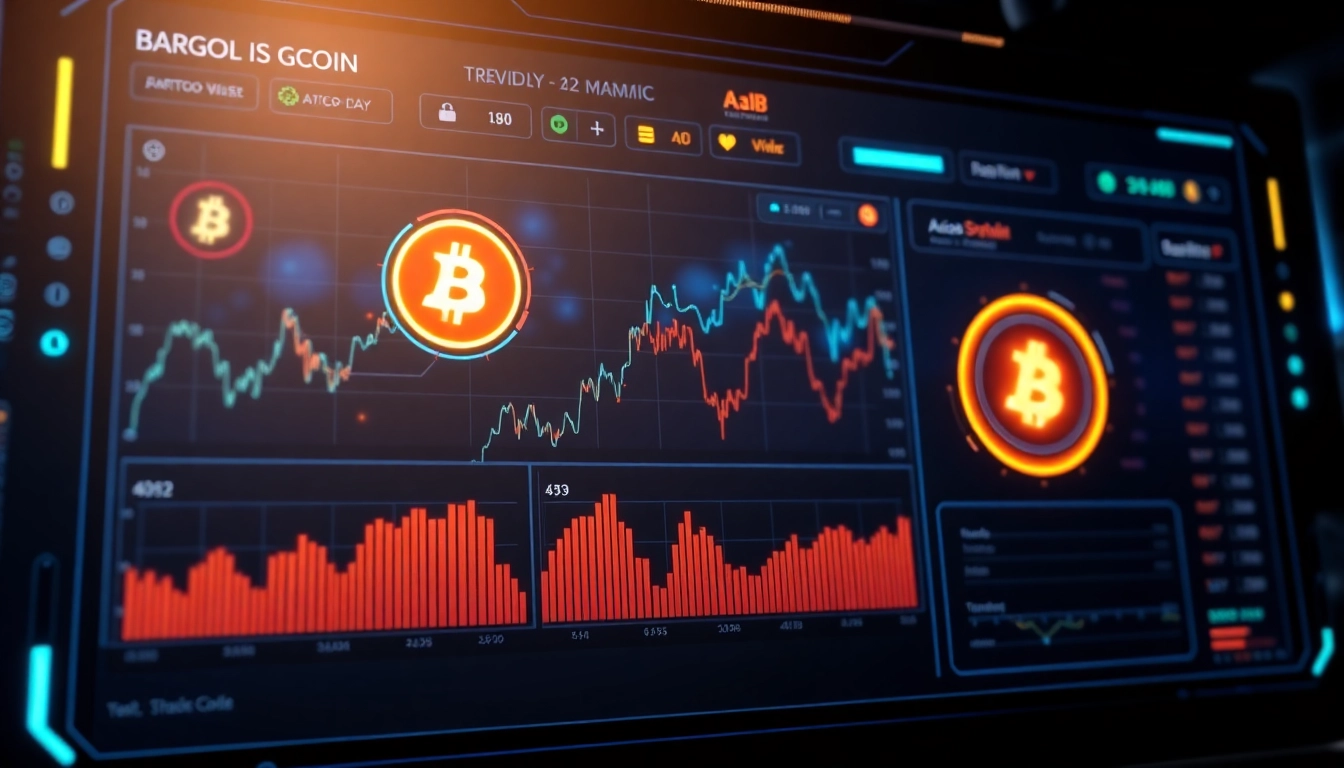Introduction to Trading View and Its Core Features
In the rapidly evolving world of financial markets, having access to sophisticated charting and analytical tools is essential for traders and investors alike. trading view has established itself as a leading platform that combines advanced charting, social networking, and market analysis into a comprehensive ecosystem. Whether you’re a seasoned trader or a beginner, understanding the core features of Trading View can significantly enhance your ability to make informed trading decisions and stay ahead of market trends.
Understanding the Trading View Interface
The Trading View interface is designed to be intuitive yet powerful, catering to a broad spectrum of users. The main dashboard provides customizable layouts where you can display multiple charts simultaneously, track real-time data, and access a plethora of tools. The user-friendly navigation bar allows quick access to various features such as the market screener, watchlists, social ideas, and trading panels. The platform’s modern design promotes seamless transitions between tools, making complex analysis accessible without overwhelming beginners.
One of the key strengths of the interface is its flexibility. Users can adjust chart scales, color schemes, and layout configurations to suit personal preferences. The platform is seamlessly accessible via web browsers and integrated mobile apps, ensuring that traders can stay connected and analyze markets on the go.
Key Tools and Widgets for Market Analysis
Trading View offers an extensive suite of tools vital for robust market analysis. These include:
- Technical Indicators: Over 100 built-in indicators such as Moving Averages, RSI, MACD, Bollinger Bands, and Fibonacci Retracement to identify trends and potential reversal points.
- Drawing Tools: Trend lines, channels, Fibonacci fans, and text annotations for precise chart marking and pattern recognition.
- Economic Calendar: Real-time updates on economic events that influence markets, allowing traders to anticipate volatility.
- Volume Profile and Market Profile: Visual insights into trading activity at specific price levels.
- Heatmaps and Sector Analysis: Visual tools highlighting market strength across sectors and asset classes.
Additionally, widgets such as social chat windows and idea sharing enable traders to collaborate and learn from community insights, elevating the analytical process beyond static chart patterns.
Overview of Chart Types and Customization Options
Traders can choose from a variety of chart types tailored to specific analysis styles, including:
- Line Charts: Simplistic trend visualization, ideal for quick overview.
- Bar and Candlestick Charts: Detailed price action representation with open, high, low, and close data, essential for technical analysis.
- Heikin-Ashi: Smoother charts that help identify trend direction and strength.
- Renko and Point & Figure: Focus on price movements, filtering out noise for clearer signals.
Customization options allow users to modify colors, add or remove indicators, and layout multiple charts for comparative analysis. Saving custom templates facilitates consistency and efficiency in ongoing analysis, making Trading View a versatile tool for diverse trading strategies.
Effective Trading View Strategies for Traders
Utilizing Technical Indicators on Trading View
Technical indicators are the backbone of market analysis on Trading View. Effective traders combine multiple indicators to confirm trends and entry or exit points. For example, a common approach involves using Moving Averages (MA) to identify trend direction, combined with RSI to spot overbought or oversold conditions. Chart overlays, such as MACD crossovers, help verify momentum shifts. Advanced users deploy custom scripts available via Trading View’s Pine Script language, creating tailored indicators that suit specific trading styles.
Setting Alerts and Notifications for Timely Actions
Timeliness is crucial in trading. Trading View enables users to set highly customizable alerts based on price levels, indicator conditions, or drawing tools. Alerts can be delivered via email, SMS, or push notifications on mobile apps, ensuring traders never miss critical market moves. Strategically configuring alerts around key support/resistance levels or indicator crossovers helps traders execute trades with precision, minimizing emotional decision-making.
Creating and Sharing Trading Ideas with the Community
Trading View’s social platform fosters a collaborative environment where traders share insights, charts, and strategies. Creating well-explained trading ideas with annotated charts not only solidifies personal understanding but also attracts feedback from the global community. Engaging with others’ ideas provides diverse perspectives and market intelligence, enriching your analytical skills. Building a reputation through thoughtful sharing can open networking opportunities and improve trading confidence.
Advanced Techniques to Maximize Trading View Utility
Integrating Trading View with Third-Party Trading Platforms
For traders seeking automated execution, Trading View can be integrated with various brokerage platforms via Trading View’s Trading Panel feature. This allows direct trading, order management, and account viewing without leaving the chart environment. API integrations and third-party tools extend Trading View’s capabilities, enabling seamless automation and advanced order strategies that align with your trading plan.
Employing Backtesting and Simulation Tools
Backtesting is essential to validate strategies before risking real capital. Trading View’s Pine Script allows traders to develop custom algorithms and test them against historical data with ease. Simulation modes help estimate real-time performance, refine parameters, and adapt strategies under different market conditions, all within the platform. Mastery of backtesting reduces knee-jerk reactions and promotes data-driven decision-making.
Optimizing Watchlists and Portfolio Management
Custom watchlists enable swift monitoring of selected assets, sectors, or trading setups. Trading View supports highly customizable watchlists with real-time updates and alerts, facilitating quick action based on predefined criteria. Portfolio management tools help track profit/loss, leverage, and diversification, providing a holistic view of your investments. Streamlining these processes enhances focus and operational efficiency in active trading environments.
Overcoming Common Challenges with Trading View
Handling Data Overload and Chart Clutter
The abundance of tools and data can overwhelm users, leading to analysis paralysis. To combat this, establish a systematic approach by filtering indicators, creating dedicated workspace layouts, and saving templates tailored to specific analysis styles. Regularly declutter your workspace by removing unused tools, and focus on essential information that aligns with your strategy.
Maintaining Accuracy with Real-Time Data
Ensuring data accuracy is paramount. Always verify your data source settings and maintain a stable internet connection. Choose reliable broker integrations and confirm that your chart updates are synchronized with live market feeds. Using Trading View’s data synchronization features ensures your analysis reflects real-time market conditions.
Ensuring Platform Stability During Volatile Markets
During high volatility, platform stability becomes critical. To prevent disruptions, keep your browser or app updated, and avoid overcrowding your workspace with excessive indicators. Utilize alerts to navigate rapid market changes, and consider using multiple devices or backup connections to stay connected during critical moments.
Measuring Success and Continuous Improvement
Tracking Trading Performance Metrics
Successful traders regularly review their performance by tracking key metrics such as win rate, risk-reward ratio, and average profit/loss per trade. Trading View offers portfolio analysis tools that help identify strengths and weaknesses, guiding future adjustments. Consistent monitoring fosters disciplined trading and steady growth.
Adapting Strategies Based on Market Feedback
Markets are dynamic; therefore, adaptability is essential. Use Trading View’s community ideas, backtesting results, and ongoing analysis to refine your strategies. Maintain flexibility to adjust indicators, timeframes, and trade management rules as new data and patterns emerge.
Leveraging Community Insights for Growth
Engaging with the Trading View community offers real-world insights and diverse approaches. Analyze trending ideas and discuss market movements to enhance your understanding. Sharing your insights and receiving feedback accelerates learning curves, ultimately translating into improved trading decisions.



